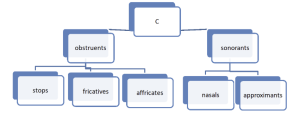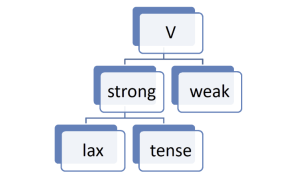The International Phonetic Alphabet (IPA)
This Pronunciation textbook uses phonetic symbols from the International Phonetic Alphabet (or IPA). The huge advantage of the IPA is that it has a symbol for every sound of the (English) language. This is important because there are many more sounds in the language than there are letters in the alphabet.
An example
The eight words below all contain the letter o. The pronunciation of these o’s, however, is different in each word:
- bone
- done
- gone
- cord
- word
- womb
- woman
- women
If we want to know how these letters are actually pronounced, we need a system that has “letters” for each of these sounds. This system is the IPA. Here’s the same list of words, with the ones in IPA next to it, which clearly shows that all vowels are pronounced differently:
- bone → /boʊn/
- done → /dʌn /
- gone → /gɑːn/
- cord → /kɔrd/
- word → /wɜrd/
- womb → /wuːm/
- woman → /ˈwʊmən/
- women → /ˈwɪmən/
It is useful to know what sounds the IPA symbols represent, especially if you wish to do the phoneme discrimination exercises.
Some IPA symbols are the same as regular orthographic letters that represent consonants or vowels, e.g. /f/, /s/, /u/, or /i/. However, most of the IPA symbols are quite different.
Here are the symbols that are different from regular letters with examples:
| Vowel symbol | Example |
| ʊ | pull, foot |
| ɪ | tin, kitten |
| ʌ* | cup, funny |
| æ* | laugh, fan |
| ɔ** | horse, more |
| ɛ | bed, letter, head |
| ɜ** | burn, bird |
| ɑː | hot, father |
| ə | about, ago, panda, fever |
| aɪ | high, find |
| aʊ | cow, meow |
| ɔɪ | boy, toy |
| eɪ | name, stain |
| oʊ | home, moan |
* never occurs before /r/ in General American
** only occurs before /r/ in General American
| Consonant symbol | Example |
| θ | thing, author |
| ð | the, these, other |
| ʃ | ship, pressure, nation |
| ʒ | measure, beige, vision |
| t͡ʃ | watch, choose, picture |
| d͡ʒ | judge, junk, adjourn |
| ŋ | song, running |
| j | young, yes |
Fig. 1 The consonants of General American (GA)

| /p,b/ pit, bit | /f,v/ fan, van | /t͡ʃ,d͡ʒ/ check | /m/ meal | /l/ lip | ||||
| /t,d/ tan, Dan | /θ, ð/ think, this | judge | /n/ Neil | /r/ rip | ||||
| /k,g/ cold, gold | /s,z/ Sue, zoo | /ŋ/ sing | /j/ yes | |||||
| /ʃ,ʒ/ shoot, beige | /w/ why | |||||||
| /h/ hall |
Fig. 2 The vowels of General American (GA)
Strong vowels of GA
| Lax monophthongs | Tense monophthongs | Tense diphthongs |
| ʊ − foot | iː − bean | aɪ − fine |
| ɪ − tin | uː − spoon | aʊ − town |
| ɛ − fell | ɑː − Pa | ɔɪ − toy |
| æ − cat | eɪ − pain | |
| ʌ − run | oʊ − home |
Weak vowels of GA
| ə − about, panda |
| ɪ − roses, setting |
| i − happy, radio |
| u − unite |
| oʊ − window |
R-colored vowels
| ɪr − beer | ɛr − air |
| ɜr − bird | ɑr − car |
| ɔr − oar | ʊr − tour |
| ər − murder, color |
Lax vowels (also known as checked vowels) can only occur in closed syllables (ending in a consonant); tense vowels can occur in both open and closed syllables. Weak vowels only occur in unstressed syllables. A limited set of vowels occurs before /r/: the /r/-colored vowels.

